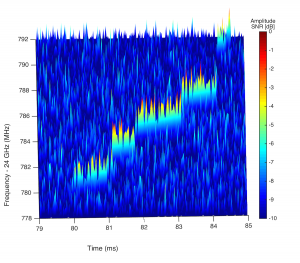Dark Matter

The Large Underground Xenon (LUX) experiment operated a 370 kg dual-phase xenon TPC at the 4850′ level of the Sanford Underground Research Facility (SURF) in Lead, SD. LUX has set the most stringent limits on the spin-independent WIMP-nucleon cross section in the mass range above 4 MeV/c^2, making it the most sensitive dark matter direct detection experiment in the world since 2013. It has ceased operations in 2016, making way for the construction of LZ (see below).
Neutrinos

The Project 8 experiment seeks to determine the neutrino mass via the precise measurement of the electron energy in beta decays. We have developed and demonstrated the viability of a novel technique called Cyclotron Radiation Emission Spectroscopy (CRES), which allows single electron detection and characterization through the measurement of cyclotron radiation emitted by magnetically-trapped electrons produced by a gaseous radioactive source. We are currently working on the first CRES measurement using a tritium source, and the design of a large scale detector aimed at measuring the neutrino mass.
Selected Publications
- D.S. Akerib et al. (LUX Collaboration), “Results from a search for dark matter in the complete LUX exposure”, Phys. Rev. Lett., 118, 021303, 2017.
- D.S. Akerib et al. (LUX Collaboration), “Improved Limits on Scattering of Weakly Interacting Massive Particles from Reanalysis of 2013 LUX Data”, Phys. Rev. Lett., 116, 161301, 2016.
- B. Monreal, L. de Viveiros, and W. Luszczak, “Sub-Penning gas mixtures: new possibilities for ton- to kiloton-scale time projection chambers”, arXiv:1512.04926 [physics.ins-det], 2015.
- D.M. Asner et al. (Project 8 Collaboration), “Single electron detection and spectroscopy via relativistic cyclotron radiation”, Phys. Rev. Lett. 114, 162501, 2015.
- D.S. Akerib et al. (LZ Collaboration), “LUX-ZEPLIN (LZ) Conceptual Design Report”, arXiv:1509.02910 [physics.ins-det], 2015.
- D.S. Akerib et al. (LUX Collaboration), “First results from the LUX dark matter experiment at the Sanford Underground Research Facility”, Phys. Rev. Lett. 112, 091303, 2014.
- D.S. Akerib et al. (LUX Collaboration), “The Large Underground Xenon (LUX) experiment”, Nucl. Instrum. Meth., A704, 111-126, 2013.
- D. Yu. Akimov et al. (ZEPLIN-III Collaboration), “WIMP-nucleon cross-section results from the second science run of ZEPLIN-III”, Phys. Lett. B709, 14-20, 2012.
- C. Amsler et al. (ArDM Collaboration), “First results on light readout from the 1-ton ArDM liquid argon detector for dark matter searches”, JINST 5:P11003, 2010.
- J. Angle et al. (XENON10 Collaboration), “First Results from the XENON10 Dark Matter Experiment at the Gran Sasso National Laboratory”, Phys. Rev. Lett. 100, 021303, 2008.
- A. Bueno, M.C. Carmona, J. Lozano, S. Navas, “Observation of coherent neutrino-nucleus elastic scattering at a beta beam”, Phys. Rev. D 74, 033010, 2006.
- E. Aprile et al., “Simultaneous Measurement of Ionization and Scintillation from Nuclear Recoils in Liquid Xenon as Target for a Dark Matter Experiment”, Phys. Rev. Lett. 97, 081302, 2006.
